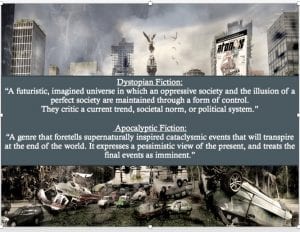We will, of course, go through this in class and give you class time in which to prepare for this assessment.
Task sheets are below.
2018 Year 12 ATAR TED PODCAST[2]-zx9low
We will, of course, go through this in class and give you class time in which to prepare for this assessment.
Task sheets are below.
2018 Year 12 ATAR TED PODCAST[2]-zx9low
The Road: Comprehension Questions
Allegory: A narrative with two levels of meaning: The surface (characters, setting, plot, etc.) and the symbolic (deeper ideas embedded within).
____________________________________________________________________________________________________________________________________________________________________________________________________________________________________________________________________________________________________________________________________________________________________________________________________________________________________________________________________________________________________________________________________________________________________________________________________________________________________________________________________________________________________________________________________________________________________________________________________________________________________________________________________________________________________________________________________________________________________________________________________________________________________________________________________________________
_____________________________________________________________________________________________________________________________________________________________________________________________________________________________________________________________________
_______________________________________________________________________________________________________________________________________________________________________________________________________________________________________________________________________________________________________________________________________________________________________________________________________________________________________________________________________________________________________________________________________________________________________________________________________________________________________________________________________________________________________________________________________________________________________________________________________________
______________________________________________________________________________________________________________________________________________________________________________
_______________________________________________________________________________________________________________________________________________________________________________________________________________________________________________________________________________________________________________________________________________________________________________________________________________________________________________________________________________________________________________________________________________________________________________________________________________________________________________________________________________________________________________________________________________________________________________________________________________
Use the image below as a STARTING POINT for your exploration of The Road by Cormac McCarthy. It is of central importance that you are able to apply the conventions of the genre to a reading of this text.

To what extent is The Road a dystopian and apocalyptic text? How does this text meet this criteria?
Please look carefully at the opening to a narrative response below and please note the annotations:
The main teaching and learning points are listed below:
In short, the paragraph above is designed to get the reader asking questions, it’s meant to engage them and immerse them in the narrative. The next part of the narrative would need to pick up the pace…
Please note the dot points below which represent feedback on one of the student presentations. You will need to use this feedback to modify your own presentations to ensure they are as effective as possible.
Please note the task sheet is also available for download from SEQTA.
I’m looking for the following things from your presentation:
Sample Questions_for students[1]-1mjl1ir
Above are a number of questions which might be used as practice questions in advance of your assessment on ‘High Noon’ and ‘The Dressmaker’ this week.
Please note that the assessment is 60 minutes in duration and the questions are unseen. No notes will be permitted in the assessment and you are reminded to leave your mobile ‘phone in your locker as per our school assessment policy.
Below is a screenshot of the modelled example from today’s lesson. Please note the annotations in both green and red.
There are a number of features to note in this modelled example:
It is important that you use the modelled examples I’ve given you to consolidate your understanding of STRUCTURE. The ideas in your own body paragraphs should be your own. There is an expectation that your assessments next week will embrace the structures and frameworks I’ve given you but you’ll need to ensure you have practiced them before you sit your assessment next week.
Below is a screenshot of an annotated modelled example based on the question deconstruction from a previous lesson:
You need to note the following structure:
In other words, it follows the ‘TEEL’ structure in an entirely clear manner.
Attached below are the body paragraphs themselves (un-annotated):
Responding Section Body Paragraphs-1gc5bsw
These paragraphs offer a comparative approach to writing about more than one text. The second body paragraph (on The Dressmaker) suggests a difference between this text and the first text written about (High Noon).
Please note that these paragraphs are sample/model paragraphs and therefore don’t contain ALL that could be said about the resolution of each text. There is more than can be said about each text and I would expect your paragraphs to include more detail.
However, I want you understand the STRUCTURE of an effective body paragraph and be able to apply this structure to your own work, your own ideas.